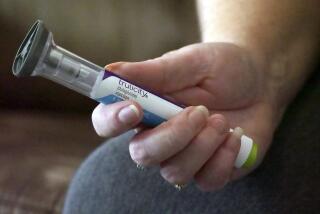Millions of Americans Unaware They Have Diabetes
- Share via
Tuesday is American Diabetes Alert Day, an effort to raise awareness of a disease that affects about 16 million Americans--half of whom don’t know they have diabetes. Free diabetes testing will be held at select hospitals, community centers and clinics. Call (213) 966-2890 for a listing of screening sites.
Other diabetes facts:
* The causes of diabetes are not known, but researchers believe that the tendency for diabetes is present at birth.
* Diabetes causes 178,000 deaths annually in the United States; it is the fourth-leading cause of death.
* About 800,000 people have type 1 diabetes. Type 1 used to be called juvenile-onset diabetes because it occurs most often in children and young adults. But the name was changed after doctors realized it could occur at any age. In this form of diabetes, the pancreas stops making insulin or makes only a tiny amount. Insulin must be injected every day.
* The most common symptoms of diabetes are: frequent urination, excessive thirst, extreme hunger, dramatic weight loss, irritability, weakness and fatigue, nausea and vomiting. People with type 1 diabetes may also experience recurring or hard-to-heal skin, gum or bladder infections; drowsiness; blurred vision; tingling or numbness in hands or feet; itching.
* The peak incidence for the onset of type 1 diabetes is around puberty.
* The majority of diabetics have type 2 diabetes (about 15 million Americans). In type 2, the pancreas produces some insulin, but it is not used very well.
* The risk of developing type 2 diabetes increases with age. Nearly 11% of Americans between 65 and 74 have type 2 diabetes.
* Another, less common, form of diabetes is gestational diabetes. This condition first occurs during pregnancy and usually disappears after delivery. However, nearly 40% of women with gestational diabetes develops diabetes within 20 years.
* People at highest risk for diabetes are 45 and older, overweight, sedentary and have a family history of the disease.
* Certain ethnic groups are at higher risk for developing diabetes. These include African Americans, Latinos, Native Americans, Asians.
* As many as 21% of all diabetics will have evidence of diabetic retinopathy after 20 years. This is a type of vision impairment caused by the disease in which the small blood vessels of the eyes weaken or leak. Diabetes is responsible for 8% of all cases of blindness in the U.S.
* About 60% to 70% of people with diabetes have mild to severe forms of diabetic nerve damage, which, in severe forms, can lead to lower limb amputations. African American women have the highest incidence of diabetes-related amputations.
* People with diabetes are also two to four times more likely to have heart disease and are two to four times more likely to suffer a stroke.
Source: American Diabetes Assn.
Resources:
* American Diabetes Assn. Western Region (serving California and Nevada): (213) 966-2890.
* American Diabetes Assn., National Headquarters, 1660 Duke St., Alexandria, VA 22314; (703) 549-1500.
* To call up the ADA Web site: https://www.diabetes.org. The Juvenile Diabetes Foundation: (800) 533-2873.





